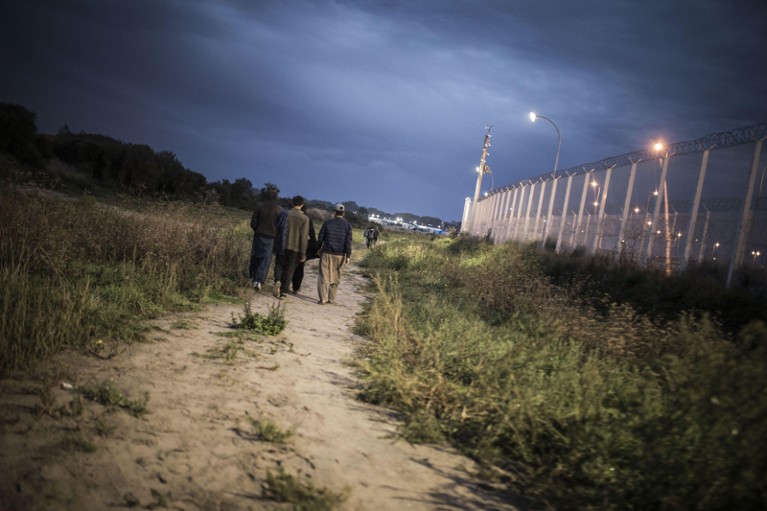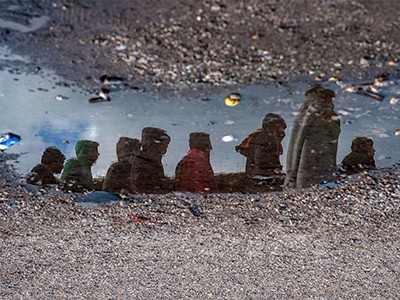
A better way to determine age could defuse political tension about treatment of refugees.Credit: Barbaros Kayan/MOKU/SIPA/Shutterstock
Eva Perón claimed she was younger for political reasons. Walt Disney pretended to be older to sign up for war. All sorts of people lie about their age for all sorts of reasons, and they’ve been doing so for a long time. Scandals over the past decade have forced authorities to act on false claims from footballers: the world governing body FIFA now routinely scans the wrist bones of players entering youth competitions to check that the athletes are truly young enough to compete.
Wrist scanning is one of several anatomical tests available that claim to be able to determine an individual’s maturity. They are cumbersome and unreliable. More-accurate tests are on the way. But the implications are profound, and must be discussed by researchers, policymakers and the public.
One reason that scientists are trying to improve age testing is to address controversy in Europe over the age of refugees. United Nations rules say that those under 18 years old must receive particular protection and assistance. Some adults say they are younger than they are to claim these benefits, and tabloid anger over these rare cases has fuelled political and public intolerance.
If officials who assess age on the basis of physical attributes such as height, voice and facial features suspect that a refugee is concealing their true age, they can apply tests that assess the maturity of teeth or bones.
European scientists seek ‘epigenetic clock’ to determine age of refugees
Experts are right to condemn these techniques as being unreliable and to complain they could deny vulnerable children the help afforded to them in national laws. Could a more-reliable and evidence-based test help? Such a test would not answer all the questions posed by Europe’s refugee crisis; almost four million people have claimed asylum since 2014, sparking a rise of xenophobia in parts of society and creating difficult decisions about how best to help immigrants and who to help most. But accurate tests could, in theory, help to make the basis of these decisions objective and transparent.
As we report in a News story, some scientists say that age could be determined more accurately using a molecular test called an epigenetic clock. It looks for distinctive chemical marks that are known to steadily accumulate on DNA. In theory, the test could be performed on a simple cheek swab. The researchers developing it are confident that this method could reliably predict age to within one or two years — much better than the currently used anatomical tests, which can estimate only to within three or four years. But they also highlight that the epigenetic clock currently performs poorly for many people. And no biological test will ever be able to say for sure if a person is 17 years, 11 months or 18 years old.
Such assays must be subjected to extensive, rigorous testing across different populations, and their limitations must be made clear. Furthermore, the ethical implications should be fully debated before the tests are used to determine the age of refugees, which potentially has life-changing consequences. Such tests must always come with full consent and privacy safeguards.
There are also important implications in other spheres. A more accurate way to determine age would be useful in forensics work, for example, to help build up a profile of a suspect from blood or semen. Success would depend on the sample being large enough for analysis. What’s more, countries such as Germany currently prohibit such information being extracted from DNA tests.
Age fraud is a widespread problem in sport. In 2010, the discovery of such deception forced a Chinese gymnastics team to return the gold medals it had won at the Sydney Olympics a decade earlier. One competitor was declared to have been only 14 at the time of the competition, two years below the required age.
Last week saw violent anti-immigrant demonstrations, this time in Chemnitz in eastern Germany. Even though the number of refugees arriving in Europe has plummeted — 49,000 had arrived by this July, compared with 1.3 million throughout 2016 — tensions remain high.
Given all this, researchers should not develop, or make claims for, age-determining tests without extreme care and wide discussion. That will take time: time for the rest of society to ponder how and whether such tests should be used. Age is not just a number. Much can be at stake.

 European scientists seek ‘epigenetic clock’ to determine age of refugees
European scientists seek ‘epigenetic clock’ to determine age of refugees
 Migrants and refugees are good for economies
Migrants and refugees are good for economies







